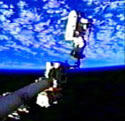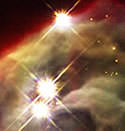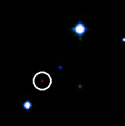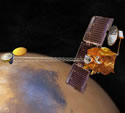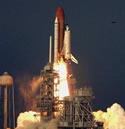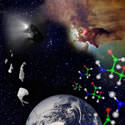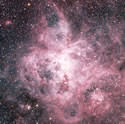
Image credit: ESO
The latest image released from the European Southern Observatory is of the Tarantula Nebula, located in the Large Magellanic Cloud approximately 170,000 light years from here. The nebula measures more than 1,000 light years across and covers the same amount of sky as the Moon. The image is a composite made up of 15 individual exposures taken with the 2.2m telescope at La Silla Observatory in Chile.
The largest emission nebula in the sky, the Tarantula Nebula (also known as NGC 2070 or 30 Doradus) is located in the Large Magellanic Cloud (LMC), one of the satellite galaxies to our own Milky Way system. Seen far down in the southern sky at a distance of about 170,000 light-years, this beautiful nebula measures more than 1000 light-years across and extends over more than one third of a degree, almost, but not quite the size of the full moon. It received its descriptive name because of the unusual shape.
It is a splendid object with a central cluster of hot and luminous young stars that powers strong emission from hydrogen and oxygen gas, making the Tarantula Nebula an easy and impressive target for observations, even with the unaided eye. It is well visible from ESO’s mountain observatories at La Silla and Paranal in Chile and it has been the object of innumerable research programmes with many different telescopes.
The present images of the Tarantula Nebula were obtained with the Wide-Field Imager (WFI) on the MPG/ESO 2.2-m telescope at the La Silla Observatory. This advanced digital camera has already produced many impressive pictures, cf. the WFI Photo Gallery [1].
As the name indicates, the WFI has a comparatively large field-of-view, 34 x 34 arcmin2, and it is therefore well suited to show the full extent of this stunning nebula.
The WFI image
PR Photo 14a/02 has been produced from 15 individual WFI-exposures obtained in September 2000. Details are available below about the way it was made.
A large number of different and colourful objects are seen in this amazing image. The very complex nebulosity is prominent in most of the field; it predominantly emits red light from hydrogen atoms (the H-alpha spectral line at wavelength 656.2 nm) and green-blue light from hydrogen atoms (H-beta line at 486.2 nm) and oxygen ions (two [O III] lines at 495.7 and 500.7 nm).
This emission is excited by the strong ultraviolet (UV) radiation emitted by hot young stars in the central cluster (known as “R136”) which were born 2-3 million years ago at the heart of the Tarantula Nebula.
Throughout the field, there are several other smaller, young open stellar clusters that are still embedded in nebulosity. Two globular clusters can also be seen, NGC 2100 at the very left of the field-of-view (see PR Photo 14d/01 below), and KMHK 1137 at the upper right (PR Photo 14e/01) [2].
Note the very different colours of these two globular clusters: the stars in NGC 2100 appear blue and bright, indicating their relative youth, whereas those in KMHK 1137 are fainter and much redder, due to their older age and possibly also the reddening effect of dust in this area.
The entire field is full of stars of very different colours and luminosity – most of them belong to the LMC, but some are foreground objects in our own galaxy, the Milky Way.
Original Source: ESO News Release

